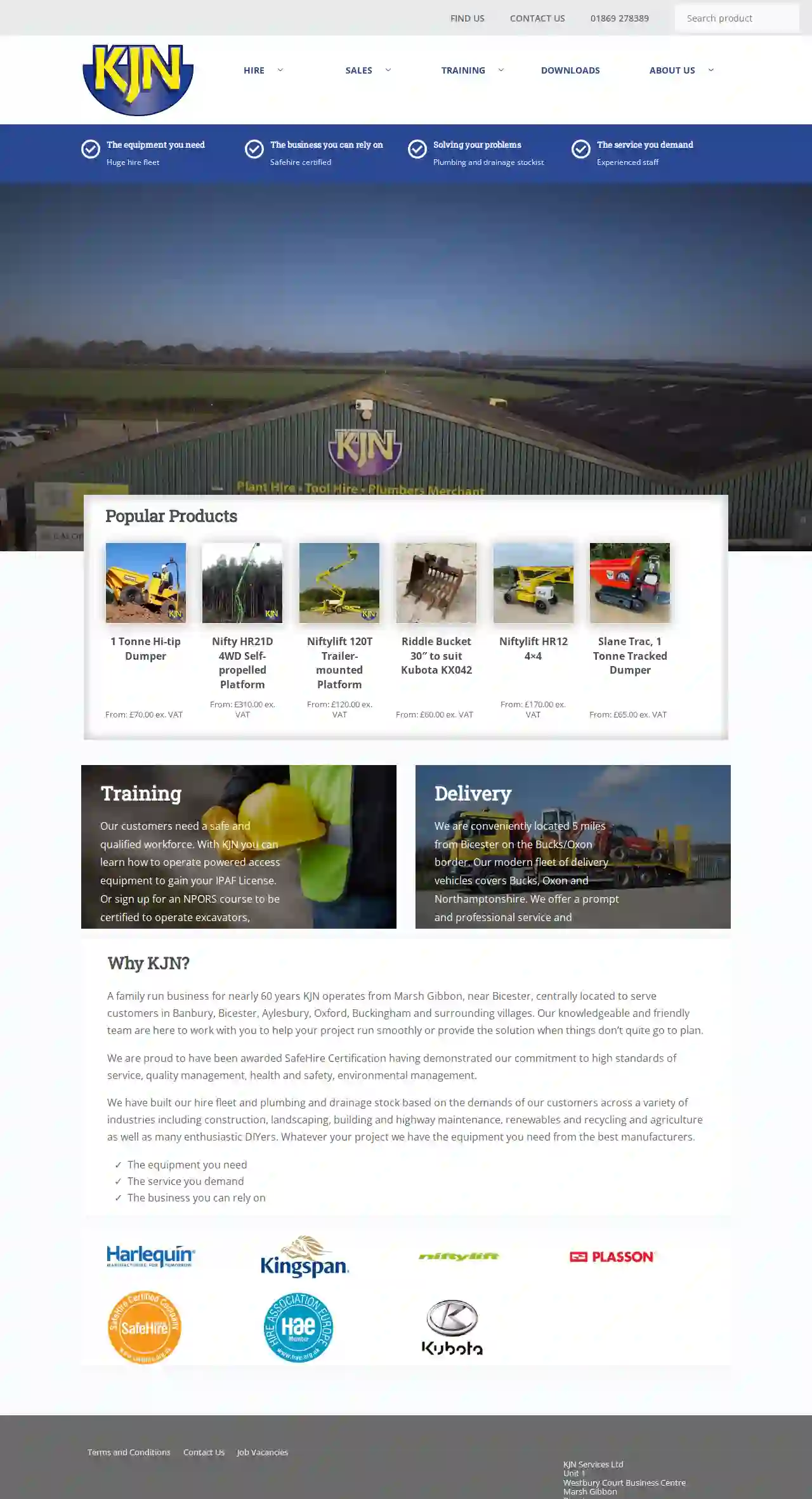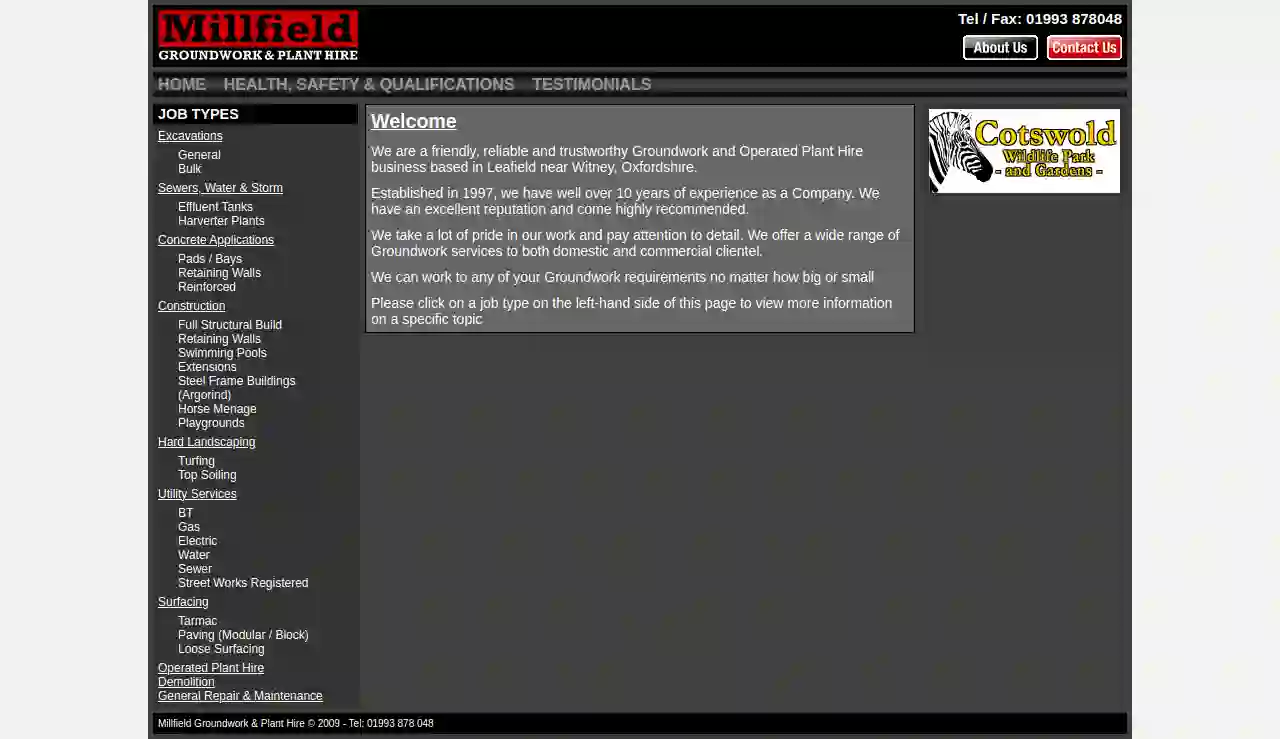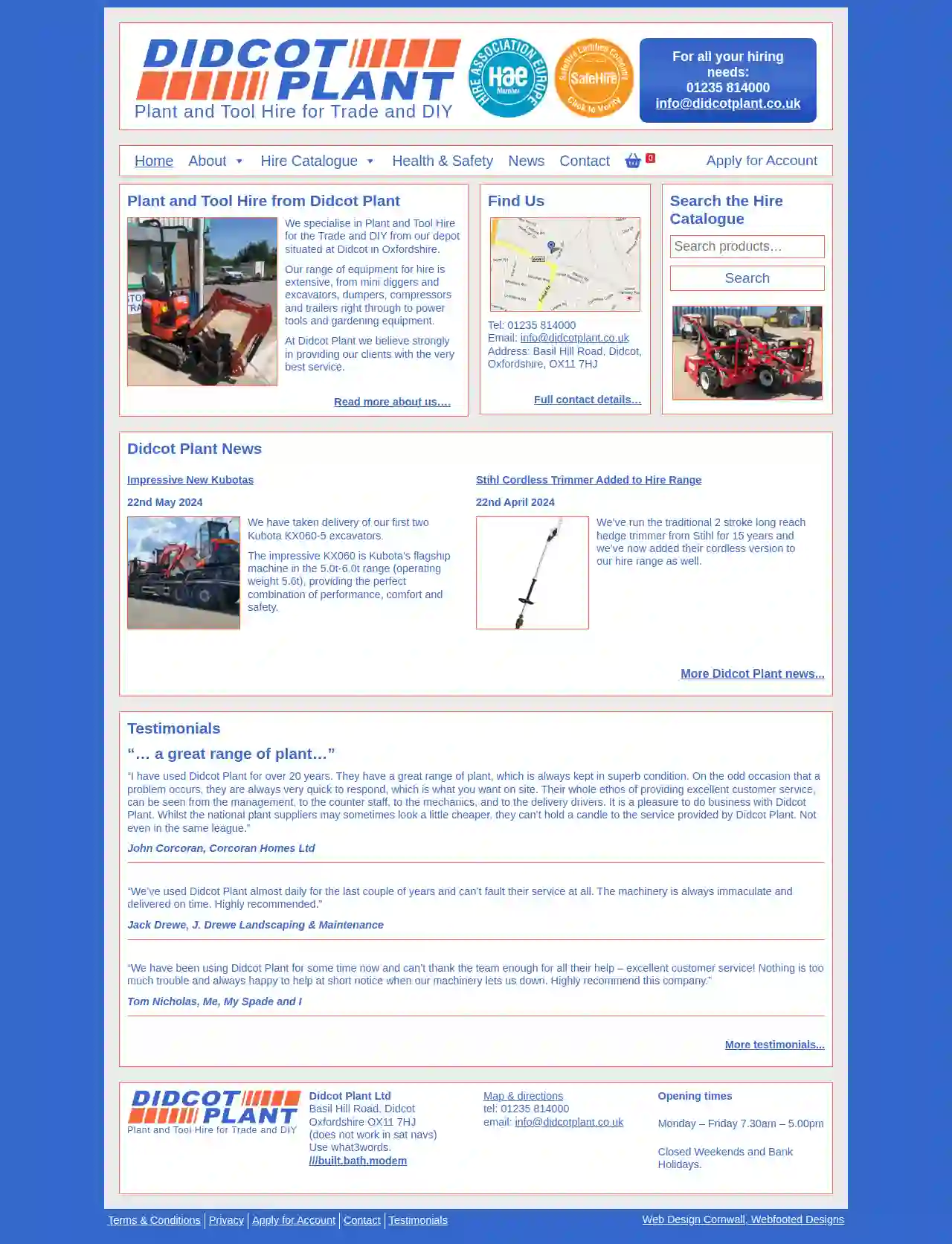Demolition Contractors Marston
Find the best Local Demolition Contractors in Marston
Receive up to 3 Demolition Services quotes for your project today! Compare profiles, reviews, accreditations, portfolio, etc... and choose the best service.

K J N Services Ltd
4.834 reviewsUnit 10, The Business Centre, Harborough Road, Kibworth, GBKJN Plant Hire KJN Plant Hire is a leading provider of plant hire and tool hire services in the UK. We offer a wide range of equipment for hire, including excavators, dumpers, telehandlers, access platforms, and more. We also offer a range of tools for hire, including breakers, drills, saws, and more. Our Mission Our mission is to provide our customers with the best possible service and value for money. We are committed to providing our customers with the right equipment for the job, at the right price, and with the right support. Our Experience We have over 20 years of experience in the plant hire industry. We have a team of experienced and knowledgeable staff who are dedicated to providing our customers with the best possible service. Our Commitment We are committed to providing our customers with a safe and reliable service. We have a strict safety policy and all of our equipment is regularly maintained and inspected.
- Services
- Why Us?
- Gallery
Get Quote
Museum of London Archaeology
Mortimer Wheeler House, 46 Eagle Wharf Road, Mortimer Wheeler House 46 Eagle Wharf Road London, London, N1 7ED, GBWe are an innovative archaeology and built heritage practice with 50 years of experience in the sector... For the past 50 years, we've provided independent, professional heritage advice and services across the UK and beyond. Our commercial services are expertly designed to help our clients in the development, infrastructure and construction sectors meet their planning process requirements. We provide the speed, certainty and value they need on projects of all sizes. We are also an educational charity, delivering award-winning community engagement and education programmes, founded on partnership and participation. As the only Independent Research Organisation (IRO) in British archaeology, we expand archaeological knowledge and collaborate with a wide range of audiences. Our story From sustainability to inclusion, find out how we've become one of the UK's leading archaeology and built heritage practices... Our offices Find out about our offices and how to get in touch with our teams across the country... Contact us Get in touch with our team... Careers We are a leading archaeology and built heritage company providing services for some of the UK's largest and most exciting infrastructure and development projects. If you’re passionate about archaeology, join us...
- Services
- Why Us?
- Gallery
Get Quote
Millfield Groundworks
31 reviewsLanley Farm, Leafield, OX29 9QD, GBMillfield Groundworks and Plant Hire: Your Trusted Partner for Groundwork Services Millfield Groundworks and Plant Hire is a friendly, reliable, and trustworthy business based in Leafield, near Witney, Oxfordshire. Established in 1997 by Andrew Millard and Peter Benfield, we have over 25 years of experience in providing high-quality groundwork services to both domestic and commercial clients. We take pride in our work and pay meticulous attention to detail. Whether you need a small, intricate project or a large-scale undertaking, we have the expertise and resources to handle it with precision and efficiency. Our team is dedicated to delivering exceptional results that exceed your expectations. We are proud to be the main contractor at the Cotswold Wildlife Park in Burford, Oxfordshire, a testament to our commitment to quality and reliability. We love what we do and consider ourselves one big family, always striving to provide the best possible service for our customers.
- Services
- Why Us?
- Our Team
- Gallery
Get Quote
FF Construction LTD
54 reviews3 Cheyney Walk, Abingdon, OX14 1HN, GBBuilding Unforgettable Memories We know now more than ever that our houses are so much more than just houses; they are places where we grow, thrive, and enjoy. Cosy places where not only you escape from a long busy day but also learn new skills and practice new hobbies. FF Construction is a building company in Oxford that builds spaces filled with light and joy. We offer a range of services to expand or refine your home, including loft conversions, rear and side extensions, basement excavation, cellar conversions and comprehensive refurbishments to mirror your vision for your home. Our ethos is quality-first craftsmanship for the very best in residential design and construction in Oxford. Let us get started on your dream home together. It's not just a building. It's a passion. We love what we do and creating a space for family and laughter is our passion. We strive for quality always and pride ourselves on the standard we achieve. Fully insured We are fully insured to give you peace of mind. Fully Certified We are fully certified to ensure the highest standards of workmanship. All Work Guaranteed We guarantee all our work to give you peace of mind. Commitment We are committed to providing our clients with the highest quality service.
- Services
- Why Us?
- Testimonials
- Gallery
Get Quote
Scane and Sons
54 reviewsOxford, GBBuilding Excellence from the Ground Up Expert groundwork contractors and civil engineers based in South Oxfordshire. Domestic and Commercial Groundwork Contractors and Civil Engineers We are Scane & Sons Ltd, an independent, family-run company providing fully bespoke groundworks solutions in Oxfordshire and the surrounding counties. Offering a wide range of groundwork and civil engineering services, our team excels at basement groundworks and construction, and we're regionally renowned foundation installers. You can also rely on us for the safe demolition of existing structures, bulk excavations and all ensuing groundworks. Put simply, we provide a complete service package designed to cover all your needs. About our company Put simply, we provide a complete service package designed to cover all your needs. Gallery Some Of Our Key Service Areas Include: Abingdon, Aylesbury, Henley, Oxford, Thame and Witney, Berkshire, Buckinghamshire, Northamptonshire and Oxfordshire. Contact us today Unrivalled Expertise in Groundwork and Construction Over 50 years of expertise At Scane & Sons Ltd, experience defines everything we do. Our workforce shares over 50 years of industry expertise and we use this knowledge to inform every aspect of the services we provide, ensuring your complete satisfaction. We can help you with: Foundation Installation Surface Water Systems Bulk Excavations Concrete Pouring Drainage Preparation Foul Water Systems Retaining Walls Basement Groundworks and Construction Demolition Civil Engineering Road Construction General Groundworks Why Choose Us? What our clients say Experience With over 50 years of shared experience, our foundation installers and groundwork specialists plan your project with a meticulous eye for detail. No matter the circumstances, we always find the best solution in the most cost-effective way. Satisfaction Guaranteed For your peace of mind, we can arrange site visits to show you examples of our previous work. Scane & Sons Ltd provides a satisfaction guarantee before producing your invoice. We also honour the warranty on the Everdure Caltite waterproof concrete used in the construction of basements and other below-ground structures. A Highly Trained and Qualified Team We hold all the qualifications you would expect from leading groundwork contractors. These include: CPCS cards for the plant sector Street Works approval SSSTS for safe site supervision CSCS Health & Safety training
- Services
- Why Us?
- Gallery
Get Quote
Jennings Carpentry & Construction Ltd
Waylands, Faringdon Road, Abingdon, OX13 5AG, GBExpert Carpentry & Building Services in Oxfordshire Transform Your Home with Our Professional Craftsmanship Based in the heart of Abingdon, Jennings Carpentry & Construction Ltd is your trusted partner for all carpentry, joinery, and construction needs throughout Oxfordshire. With a rich history of transforming spaces, our team of skilled professionals is dedicated to delivering exceptional craftsmanship on every project, no matter the size or complexity. We pride ourselves on our versatile expertise. Whether you’re looking to extend your home, renovate your kitchen, install new doors, or construct a sturdy, beautiful roof, we’ve got you covered. Excellence in Every Detail Our portfolio includes work on a diverse range of buildings, from charming traditional cottages to modern new builds, and even the prestigious University Colleges in Oxford. Our team approaches each job with meticulous care, ensuring that every aspect meets our stringent quality benchmarks. Call us today on 07584 437 388 to discuss your project - no job is too big or small and we're happy to help.
- Services
- Why Us?
- Our Team
- Testimonials
- Gallery
Get Quote
Didcot Plant
4.860 reviewsBasil Hill Road, Didcot, Oxfordshire, OX11 7HJ, GBPlant and Tool Hire from Didcot Plant We specialise in Plant and Tool Hire for the Trade and DIY from our depot situated at Didcot in Oxfordshire. Our range of equipment for hire is extensive, from mini diggers and excavators, dumpers, compressors and trailers right through to power tools and gardening equipment. At Didcot Plant we believe strongly in providing our clients with the very best service. Read more about us….
- Services
- Why Us?
- Testimonials
- Gallery
Get Quote
Grab Hire Bicester ️
51 reviewsUnit 1, Bicester Business Park, Bicester, OX26 6AA, GBAbout Grab Hire Bicester Grab Hire Bicester is a reputable and reliable grab hire company serving Bicester and the surrounding areas. We offer a wide range of grab hire services, including: Excavation Site clearance Demolition Waste removal Aggregates delivery Our team of experienced operators are committed to providing a professional and efficient service. We have a modern fleet of grab lorries, all equipped with the latest safety features. We are also fully insured and licensed to operate in the UK. We pride ourselves on our competitive pricing and our commitment to customer satisfaction. We are always happy to discuss your specific requirements and provide a free, no-obligation quote.
- Services
- Why Us?
Get Quote
Oxford Archaeology
4.313 reviews12a St. Clements Street, Oxford, GBOxford Archaeology: Uncovering the Past, Shaping the Future Oxford Archaeology is a leading archaeological practice in the UK, renowned for its expertise in delivering high-quality archaeological services across a wide range of projects. With over 50 years of experience, we have built a strong reputation for our commitment to excellence, innovation, and community engagement. Our Mission Our mission is to uncover the past, understand its significance, and share our knowledge with the world. We strive to provide our clients with the highest quality archaeological services, while also ensuring that our work benefits the wider community. Our Values Our values are at the heart of everything we do. We are committed to: Excellence in all that we do Innovation and creativity in our approach Collaboration and partnership with our clients and stakeholders Community engagement and outreach Sustainability and environmental responsibility Our Services We offer a wide range of archaeological services, including: Archaeological surveys and assessments Excavations and fieldwork Post-excavation analysis and reporting Heritage management and planning Public engagement and outreach Research and publication Our Team Our team is made up of highly skilled and experienced archaeologists, who are passionate about their work. We are committed to providing our clients with the best possible service, and we are always looking for new ways to improve our work.
- Services
- Why Us?
- Gallery
Get Quote
Oxford Civil Group Inc.
3.73 reviews313 Tecumseh St, Woodstock, N4S 7W1, GBAbout Oxford Civil Group We are a local, full-service heavy civil construction company specializing in sewer and watermain installation, road construction, infrastructure, earthworks and site development. With a combined experience of more than 55 years in civil construction, our team can be counted on to bring a knowledgeable and solutions-based approach to every job. Incorporated in 2016, we’ve built our reputation for excellence one satisfied client at a time, increasing our highly qualified team over the years to meet the demand of continued growth. Professional, meticulous, and results-driven, Oxford Civil Group is the company whose machines you want on site. Thinking about a project? Bring your plans to us, and our expert team will look after the rest!
- Services
- Why Us?
- Gallery
Get Quote
Over 13,059+ Excavation Pros on our platform
Our excavation contractors operate in Marston and surroundings!
ExcavationHQ has curated and vetted the Best Excavation Pros arround Marston. Find the most trustworthy business today.
Frequently Asked Questions About Demolition Contractors
- Recycling: Concrete, brick, metal, and wood can be recycled and reused in other construction projects, reducing waste sent to landfills.
- Landfill Disposal: Non-recyclable materials are disposed of in designated landfills according to local regulations.
- Donation: Some materials, such as fixtures or appliances, may be suitable for donation to charitable organizations.
- Size and Type of Structure: The method should be suitable for the structure's size, height, and construction materials.
- Site Location and Accessibility: The method should be feasible given the site's location, surrounding buildings, and access constraints.
- Environmental Considerations: Prioritize methods that minimize environmental impact, such as deconstruction or selective demolition if feasible.
- Budget: Different demolition methods have varying costs, so choose one that fits your budget.
- Safety: Prioritize methods that ensure worker safety and minimize risks to surrounding areas.
- Safety: Experienced contractors have the knowledge, skills, and safety training to execute demolitions safely, minimizing risks to workers and surrounding areas.
- Efficiency: Contractors have the specialized equipment and expertise to complete demolitions efficiently, saving time and reducing project costs.
- Compliance: Reputable contractors are familiar with local regulations and permitting requirements, ensuring compliance and avoiding legal issues.
- Waste Management: Contractors have waste management plans to handle debris responsibly, including recycling and proper disposal.
- Liability Protection: Insured contractors protect you from financial responsibility for accidents or damages during the demolition process.
What happens to the debris after demolition?
How do I choose the right demolition method for my project?
What are the benefits of hiring a professional demolition contractor?
What is a demolition bond?
What happens to the debris after demolition?
- Recycling: Concrete, brick, metal, and wood can be recycled and reused in other construction projects, reducing waste sent to landfills.
- Landfill Disposal: Non-recyclable materials are disposed of in designated landfills according to local regulations.
- Donation: Some materials, such as fixtures or appliances, may be suitable for donation to charitable organizations.
How do I choose the right demolition method for my project?
- Size and Type of Structure: The method should be suitable for the structure's size, height, and construction materials.
- Site Location and Accessibility: The method should be feasible given the site's location, surrounding buildings, and access constraints.
- Environmental Considerations: Prioritize methods that minimize environmental impact, such as deconstruction or selective demolition if feasible.
- Budget: Different demolition methods have varying costs, so choose one that fits your budget.
- Safety: Prioritize methods that ensure worker safety and minimize risks to surrounding areas.
What are the benefits of hiring a professional demolition contractor?
- Safety: Experienced contractors have the knowledge, skills, and safety training to execute demolitions safely, minimizing risks to workers and surrounding areas.
- Efficiency: Contractors have the specialized equipment and expertise to complete demolitions efficiently, saving time and reducing project costs.
- Compliance: Reputable contractors are familiar with local regulations and permitting requirements, ensuring compliance and avoiding legal issues.
- Waste Management: Contractors have waste management plans to handle debris responsibly, including recycling and proper disposal.
- Liability Protection: Insured contractors protect you from financial responsibility for accidents or damages during the demolition process.